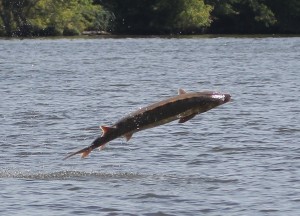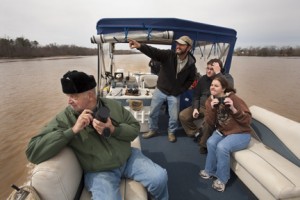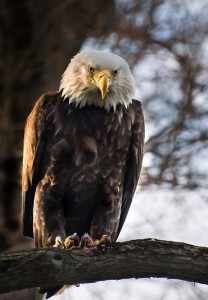
A bald eagle perched up in the trees during the autumn. The resident eagles along the James do not migrate.
Photo courtesy of Discover the James / Photo by Shelley Fowler
When choosing a place to establish roots, humans and other species look for similar qualities in their homes. The earliest settlers chose what is now Richmond because of its prime location along the James, and many animals thrive off of having the riparian zone near as well.
In a perfect world where humans harmoniously shared space, this would be fine – but that does not always go as planned. Pollution in the James reached levels so high that after 1975, bald eagles were completely extinct in the area.
A social movement sparked once the birds went missing from the horizon. After the Clean Water Act was enacted and the pesticide DDT was banned from the river, the eagles were able to make an exponentially great return. The first bird came back to the James in 1979, and since then it has been a curve that only goes up. Today, the birds have made a 100 percent recovery with over 230 pairs of resident eagles along the James.
When I went searching for bald eagles, I was not fortunate enough to see a bird. However, from my experience being a raft guide in Colorado, I know that eagle nests are great indicators of a healthy riparian zone.

An atlantic sturgeon breaching in the James. Fully grown sturgeons can get up to 12 feet long and weigh up to 800 pounds. Photo courtesy of Discover the James / Photo by Don West
Atlantic sturgeons, another animal that is native to the James, took a short leave of their own. Because they are up to 200 million years old, and more conservatively how they are now for the last 120 million years, they are likely the animals that have been inhabiting the river the longest.
“Sturgeons are incredible, they’re dinosaurs,” Captain Mike Ostrander, owner of Discover the James said. “They were swimming when megaraptors were on the earth.”
While there are multiple groups and organizations in Richmond who are dedicated to river conservancy and care deeply about the welfare of the animals along the river, there are also individuals who have been able to take their passion for the water and make a career out of it, such as Ostrander.
Ostrander first moved to the area 21 years ago, and came to Richmond for the James in a number of ways. Through volunteer work he discovered that he had a passion for teaching others how to fish, and his James River Fishing School.
Eventually, Ostrander had spent enough time on the water that he learned a multitude of information about the water and its inhabitants. One day, which he described as a “magic moment,” the idea of his company, Discover the James, popped into his head and he began giving guided tours.

People of all ages love taking part in eagle watching along the James. Photo courtesy of Discover the James / Photo by Lynda Richardson
His favorite part of his job is being able to share the information he knows with others to educate them, but also have fun while doing so. He said that people often scream when they see the sturgeons – some of them are up to 12 feet long – and no two experiences on the river are alike.
But not everyone can be a successful educational river guide on the James.
“You need to understand the animals, especially the birds, in order to go out there and work with them, and tune in with them,” Ostrander said.
He went on to explain that he is able to anticipate the bald eagles’ movements, and understand why they do different actions such as flying fast or calling out and looking back at their nests often.
Even though Ostrander has been a river guide for over 16 years and knows most of the bottom of the river by heart, as well as the annual lifecycle of multiple animals, he still believes that there are many people that are way more in tune with certain aspects of the river than him.

An elderly bald eagle keeping an eye on the James River.
Photo Courtesy of Discover the James / Photo by Theresa Rasmussen
Ostrander’s passion with nature was able to blossom into a full time job after a few years, and he now gets calls from people all over the country who want to book trips to see sturgeons and eagles, as well as others, months in advance.
He said that this time of year is not ideal for sturgeon tours because they are not out very much.
Regardless of the success with his company, Ostrander makes an effort to respect the space of all of his subjects. He does not do bald eagle trips in January or February because it is their mating and egg laying season.
He also does not want the project to become too big, as to not exploit the animals or the area along the river, and tries to live with them as harmoniously as possible.
“I made the decision a while ago that I just do what I do and keep it at that instead of turning it into a big jurassic park exhibit,” Ostrander said. “I’m just happy doing what I’m doing.”
